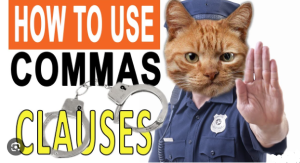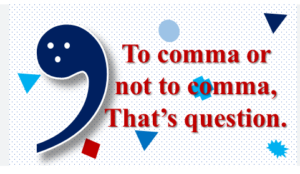This writing guide entry focuses on how to use a comma, especially for those writers who must express themselves publicly. Content creators- bloggers, authors, freelancers, copywriters, poets, etc. – are often embarrassed by the absence or presence of this, tiny, insignificant guy with a bent tail. Sadly, and far too often, the comma has added dismay or frustration to the success of budding writers.
Some writers refer to the comma as a momentary pause while others believe that it is a complex art that is too subtle to define its usage.
What is a comma?
According to the online Dictionary, a comma is a punctuation mark used to separate ideas within a sentence. Its presence indicates that the idea is paused but will continue. So, it is not a full stop. Without commas, the ideas would convey different meanings or even distort the information. Here is an example
The gardener not the racer in the black sedan hit the mark first.
The gardener, not the racer in the black sedan, hit the mark first.
The second sentence is more specific and there are no conflicts about what is being said. However, if we were to place commas where we feel like, without following the rules, the sentence would still make no sense.
The, gardener not, the racer in the black sedan, hit the mark first.
That is why commas follow a strict set of universal rules that govern their usage.
How to use Commas with Subjects and verbs?

A verb is a word or phrase that denotes an action. Subjects are the nouns or pronouns that perform this action. So, how to use commas with subjects and verbs should be fairly easy. However, some writers tend to use a coma to separate them. This should not be the case.
Brandon, kicks the blue balloon. (Incorrect)
Brandon kicks the blue balloon. (Correct)
If the subject performs multiple actions, use a conjunction and not a comma.
Brandon kicks the ball, and catches it. (Incorrect)
Brandon kicks the ball and catches it. (Correct)
Where there is a possible misunderstanding, please use a comma.
Brandon saw the frog that sings and shouted. (Misleading)
Brandon saw the frog that sings, and shouted.
This helps us understand who shouted – Brandon or the frog.
Using Commas with Multiple Nouns in a Compound Sentence
A comma is useful when multiple nouns appear in a sentence. The comma separates the subjects or objects without separating them from the verb.
Barry, Bill, and Brandon will be coming.
I write novels, short stories, and poems.
However, the rule changes a bit when faced with a compound sentence. The comma should not be used.
Brandon, and his team will play against Georgetown. (Incorrect)
Brandon and his team will play against Georgetown. (Correct)
Sometimes a writer will insert a parenthetical subject alongside the main subject. Separate the subject with commas.
James and Billy, unlike Brandon and Bob, deserved the gold medals.
The price of mangoes and cherries, not that I bought any, was ideally low.
Comma Splices – Where Writers Fail

A comma splice occurs when two sentences are joined together by a comma. This is correctly performed using a semicolon or a conjunction.
Brandon was out of eggs, he went to the grocery store.
Mary lost her lamb, she telephoned the sheriff.
There are three ways to adjust this error
- Add a conjunction: Brandon was out of eggs and he went to the grocery store.
- Use a semicolon: Mary lost her lamb; she telephoned the sheriff.
- Write two sentences: Brandon was out of eggs. He went to the grocery store.
How to Use Commas in Dates?
The rule for using commas in dates is simple and easy to follow, especially since there are only two.
- Use a comma when using the month/day/year format, use a comma to separate the year: Christmas Day is December 25, 2022. Daringo was born on April 1, 1778.
- When referring to a specific day and date: Brandon will leave on Friday, March 18, in the afternoon. Marcos is teaching today, June 26, at the annual ball. The wedding service will be held Sunday, July 5, 2001, at Barverly Chapel.
Five other essential uses of Comma
There are other important comma usages that the best writing guide can not omit. Here are five important ones that may still take us off guard.
- Commas between coordinate adjectives: When using a comma with ‘but’, make sure there are separate clauses.
Example: Tom and Brandon are here to sing, but Brandon will be the one dancing.
However, if there is only one clause do not use the comma. Tom won’t dance but will sing.
- Using a comma with ‘And: If there are only two nouns in a sentence do not use a comma before the and.
Michael, and Brandon will sing (Incorrect)
Michael and Brandon will sing. (Correct)
However, when there are three or more subjects it is optional to use the comma.
Bob, Michael, and Brandon will sing.
Bob, Michael and Brandon will sing
- The restrictive clause and the comma: Whenever a writer refers to an item within a sentence using who or that, it is called a restrictive clause. This clause is almost an adjective and the sentence would use value without it. It should not be separated by a comma
The balloon that Brandon kicked won the award
The cat that Mike won is a beauty.
- Commas in correlative conjunction: These are conjunctions that are used in pairs (either/or, neither/nor, and not just/but also) to join sentences. The use of commas is not necessary.
Neither Billy nor Brandon can dance the jig.
Either Brandon or Michael will win the lottery.
Not just buy the dishes but also the dishwasher.
- Using commas inside quotation marks: The usage of commas inside quotation marks is a local language choice. In US English, commas are placed within quotation marks.
“Brandon is not coming,” Billy said.
However, British English places the comma outside the quotation marks.
“Brandon is not coming”, Billy said.
Without correct punctuation usage, the best writing guide will be of no use to readers. That is why it is of utmost importance that we practice how to use the comma.



